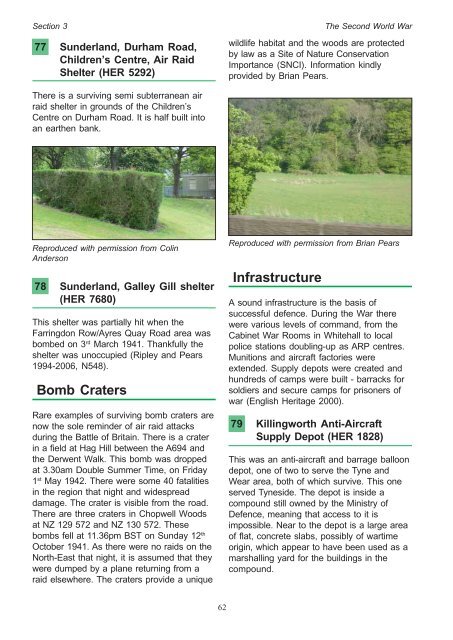TWENTIETH CENTURY DEFENCE SITES of TYNE and WEAR
TWENTIETH CENTURY DEFENCE SITES of TYNE and WEAR
TWENTIETH CENTURY DEFENCE SITES of TYNE and WEAR
Create successful ePaper yourself
Turn your PDF publications into a flip-book with our unique Google optimized e-Paper software.
Section 3 The Second World War<br />
77 Sunderl<strong>and</strong>, Durham Road,<br />
Children’s Centre, Air Raid<br />
Shelter (HER 5292)<br />
There is a surviving semi subterranean air<br />
raid shelter in grounds <strong>of</strong> the Children’s<br />
Centre on Durham Road. It is half built into<br />
an earthen bank.<br />
Reproduced with permission from Colin<br />
Anderson<br />
78 Sunderl<strong>and</strong>, Galley Gill shelter<br />
(HER 7680)<br />
This shelter was partially hit when the<br />
Farringdon Row/Ayres Quay Road area was<br />
bombed on 3 rd March 1941. Thankfully the<br />
shelter was unoccupied (Ripley <strong>and</strong> Pears<br />
1994-2006, N548).<br />
Bomb Craters<br />
Rare examples <strong>of</strong> surviving bomb craters are<br />
now the sole reminder <strong>of</strong> air raid attacks<br />
during the Battle <strong>of</strong> Britain. There is a crater<br />
in a field at Hag Hill between the A694 <strong>and</strong><br />
the Derwent Walk. This bomb was dropped<br />
at 3.30am Double Summer Time, on Friday<br />
1 st May 1942. There were some 40 fatalities<br />
in the region that night <strong>and</strong> widespread<br />
damage. The crater is visible from the road.<br />
There are three craters in Chopwell Woods<br />
at NZ 129 572 <strong>and</strong> NZ 130 572. These<br />
bombs fell at 11.36pm BST on Sunday 12 th<br />
October 1941. As there were no raids on the<br />
North-East that night, it is assumed that they<br />
were dumped by a plane returning from a<br />
raid elsewhere. The craters provide a unique<br />
62<br />
wildlife habitat <strong>and</strong> the woods are protected<br />
by law as a Site <strong>of</strong> Nature Conservation<br />
Importance (SNCI). Information kindly<br />
provided by Brian Pears.<br />
Reproduced with permission from Brian Pears<br />
Infrastructure<br />
A sound infrastructure is the basis <strong>of</strong><br />
successful defence. During the War there<br />
were various levels <strong>of</strong> comm<strong>and</strong>, from the<br />
Cabinet War Rooms in Whitehall to local<br />
police stations doubling-up as ARP centres.<br />
Munitions <strong>and</strong> aircraft factories were<br />
extended. Supply depots were created <strong>and</strong><br />
hundreds <strong>of</strong> camps were built - barracks for<br />
soldiers <strong>and</strong> secure camps for prisoners <strong>of</strong><br />
war (English Heritage 2000).<br />
79 Killingworth Anti-Aircraft<br />
Supply Depot (HER 1828)<br />
This was an anti-aircraft <strong>and</strong> barrage balloon<br />
depot, one <strong>of</strong> two to serve the Tyne <strong>and</strong><br />
Wear area, both <strong>of</strong> which survive. This one<br />
served Tyneside. The depot is inside a<br />
compound still owned by the Ministry <strong>of</strong><br />
Defence, meaning that access to it is<br />
impossible. Near to the depot is a large area<br />
<strong>of</strong> flat, concrete slabs, possibly <strong>of</strong> wartime<br />
origin, which appear to have been used as a<br />
marshalling yard for the buildings in the<br />
compound.

















